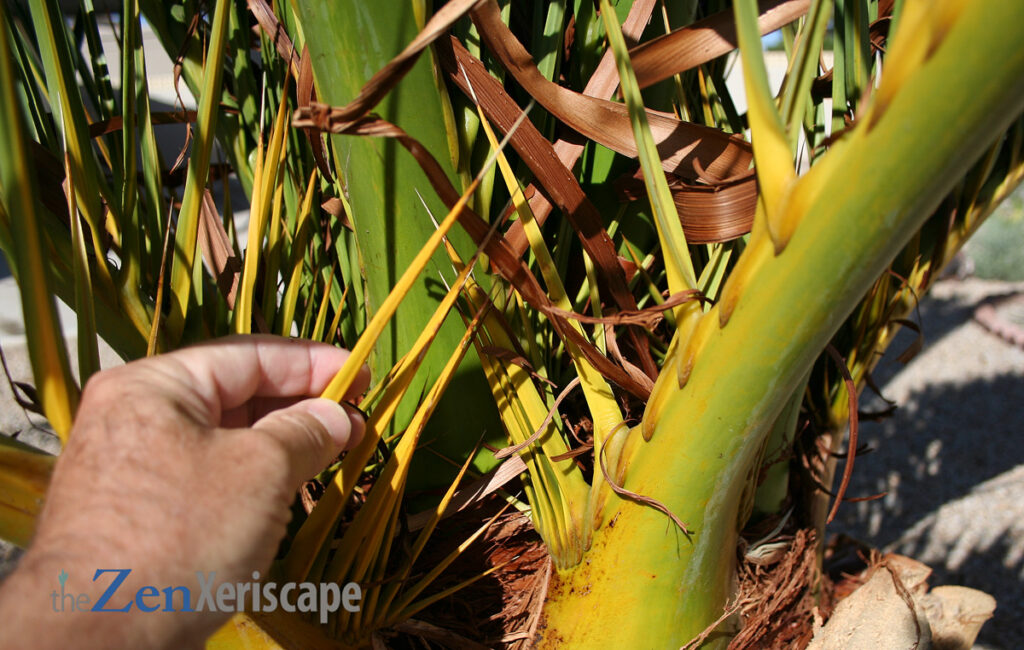The Canary Island Date Palm tree (Phoenix canariensis), also known as the pineapple palm, is one of easiest and most attractive palm trees to grow in a landscape. It’s drought-tolerant and enjoys the summer heat! Here are the Canary Island Date Palm pros and cons.

and my neighbor’s mature, established
pineapple palm across the street.
This palm tree is an attractive focal-point.
Photo by Doug Martin
Get Prime! (As an Amazon Associate, I earn a commission from qualifying purchases.)
Canary Island Date Palm pros and cons
PROS:
Large, stately appearance:
The pineapple palm tree is a perfect specimen tree for your landscape. It can grow quickly, and over the years it will develop a thick trunk, capped with a large crown of arching palm fronds.
And, the arching fronds create an attractive, tropical ambience. In addition, the crown can be pruned to resemble the shape of a ‘pineapple’, which is an eye-catching architectural feature.
Arching palm fronds can help group smaller plants:
In addition to creating a tropical feel in any landscape (even an arid xeriscape), the arching palm fronds can help group smaller accent plants. For instance, sages or other small flowering plants and bushes can be placed underneath the fronds for a beautiful, inviting tropical effect.
Versatile landscape uses:
Because of its large size and attractive features, the Canary Island date palm tree can be used in casual tropical landscape designs, or in larger office park settings. In addition, this large drought-tolerant palm tree looks fantastic in any arid landscape setting.
I have a younger, smaller pineapple palm in front of my house near Phoenix, Arizona. It does really well in the summer heat, and once established, is extremely tolerant of drought. In fact, my neighbor across the street has a large specimen with no drip irrigation, and almost no supplmental water—it still looks fantastic!
Heat-tolerant and drought-tolerant:
Once established, the Canary Island date palm tree is both heat- and drought-tolerant. During our extremely hot southwestern summers in Arizona, the pineapple palm looks better and better as it gets hotter—it’s an amazingly heat-tolerant plant.
This palm does best in USDA hardiness zones of 9-to-11, and might even do well in cooler temperature zones. However, if the temps drop below 15 degrees Fahrenheit, it should be given overnight protection from the cold. In my case, we’ve occasionally reached those low temps briefly, and my Canary Island date palms suffered no damage.
As I noted, my neighbor has a large, established date palm tree, and provides no drip irrigation, and only a little supplemental water. In my case, though, with a younger, less established palm, I do give it supplemental, deep waterings once-a-week in the summer.
Low maintenance:
Once established, this palm tree will require minimal supplemental water (depending on your environment). In addition, it doesn’t require much supplemental fertilizer, or other tweaks to spur growth. It tolerates a wide range of soils, with the primary goal of keeping the soil well-draining.
However, in my experience, this palm tree can be overwatered without fear of root rot. The water has spurred extra lush, green growth of its arching palm fronds. However, be cautious, and adapt your watering routines quickly if you spot any signs of stress.
Just like any drought-tolerant plant, do not let this palm tree sit in pooling water—the soil should drain well.
Shop for earthworm castings on Amazon! It boosts water retention and introduces beneficial microbes to suppress pests and diseases. (As an Amazon Associate, I earn a commission from qualifying purchases.)
Hardy and easy-to-grow:
I’ve found that the Canary Island date palm tree is one of the easiest plants to grow in an arid landscape. While other native plants have succumbed to our harsh southwestern summers, my pineapple palms continued to thrive.
Of course, younger, less-established pineapple palms will need more care during the first few years, just like any new landscape plant would.
Makes a great container plant:
Despite its potentially massive size, the Canary Island date palm tree makes a fantastic container plant. Its hardiness helps is survive, and the container itself can help minimize its growth potential. This tree can last many years in a large container without being repotted.
The benefit of a container-bound palm tree is that you can move it around in your landscape. Place it near your pool for an enhanced tropical feeling, then move it near your porch for social gatherings.
Canary Island Date Palm pros and cons
CONS:
Massive size:
Eventually, this palm tree, which looked so cute in a petite 5-gallon container, can get massive. Potentially, this tree can get 40-to-60 feet tall, with a canopy the spreads out over 20 feet. At a mature size, the palm fronds can be very long.
Its potentially large size means you need to place it carefully in your landscape. Don’t plant it too closely to your house, and allow enough clearance for public walkways and traffic. Many times, this palm tree’s massive size will make it impractical for many smaller residential landscapes.
Pruning tasks can be time-consuming and dangerous:
The large palm fronds must be pruned. And, its large, very sharp spines at the frond’s base are dangerous! Those spines can quickly pierce skin and penetrate deeply into flesh. And, I’m serious about that—care must be exercised when pruning.
In addition, mature female trees can produce a massive amount of fruit. The fruit is clustered on long stems, and the weight of those heavily fruited stems can be massive. So disposal of both the palm fronds and the fruit stems can be problematic.
The easy solution is to hire an experienced landscaper to prune and dispose. Hopefully, your landscaper can also prune the base of the crown into a pineapple shape. That would be awesome!

At the base of the stems, there are large,
very sharp, and very dangerous spines.
They can easily puncture flesh!
Photo by Doug Martin
Amazon has excellent landscape pruning tools, including gardening scissors, pruning saws, and loppers! (As an Amazon Associate, I earn a commission from qualifying purchases.)
Pests and diseases:
Depending on where you live, the pinapple palm tree is susceptible to various diseases and pests. For instance, the South American palm weevil can cause significant damage. In addition, this tree is vulnerable to Ganoderma butt rot as well as Fusarium wilt.
In my case, I have had a single problem with pests or diseases on my pineapple palm trees in the southern Arizona area.
Can be invasive:
Because of its hardiness, the Canary Island date palm tree can be invasive. I don’t think that would be a problem in an arid region, but in a zone that receives more rain, this tree could easily spread.
Birds love the fruits of this tree, so they can spread the large, hard seeds. Or, the fruit could drop to the ground, and excess water could transport them to other locations, where they can sprout and potentially become an unwanted forest.
You know, occasionally, I have found baby palm trees growing in my landscape. Mostly, they are the tall fan palms, but I have found a few baby pineapple palms growing. The simple solution is to just pull like a weed, or replant them somewhere. They are very hardy, so they will grow almost anywhere nearby
Protect your hands while gardening—shop for pruning gloves on Amazon! (As an Amazon Associate, I earn a commission from qualifying purchases.)
TAKEAWAYS:
Canary Island Date Palm pros and cons
In summation, I love my Canary Island date palm tree. For me, it is extremely hard and heat-tolerant. It has survived the most brutal of our southwestern summers while retaining its lush, green, tropical look.
It’s a beautiful specimen plant, that looks fantastic when grouped with smaller accent flowering plants and bushes. I’d recommend this palm tree for any arid landscape and xeriscape.
Content and photos by Doug Martin and The Zen Xeriscape



